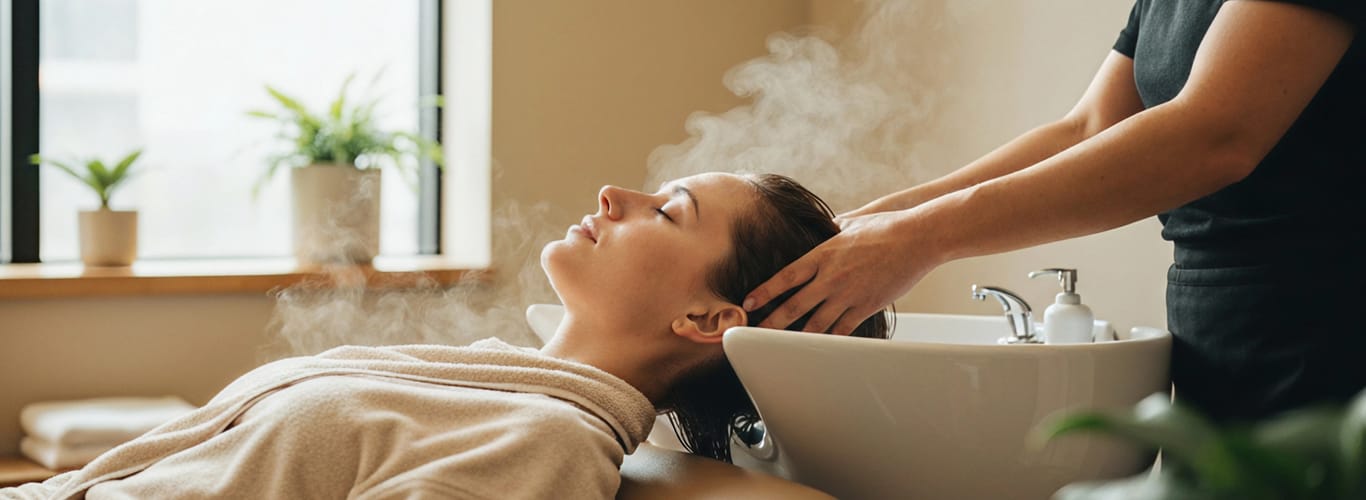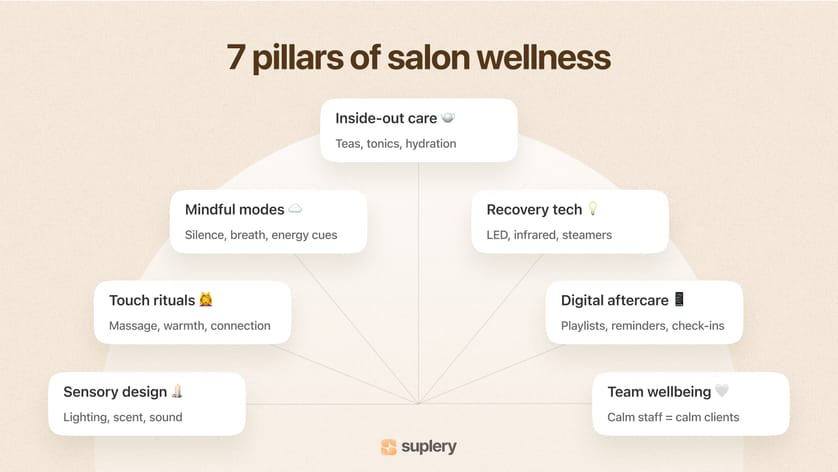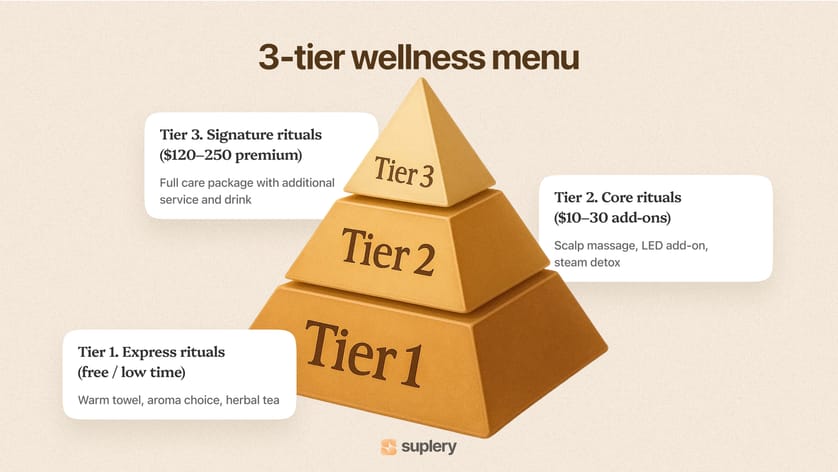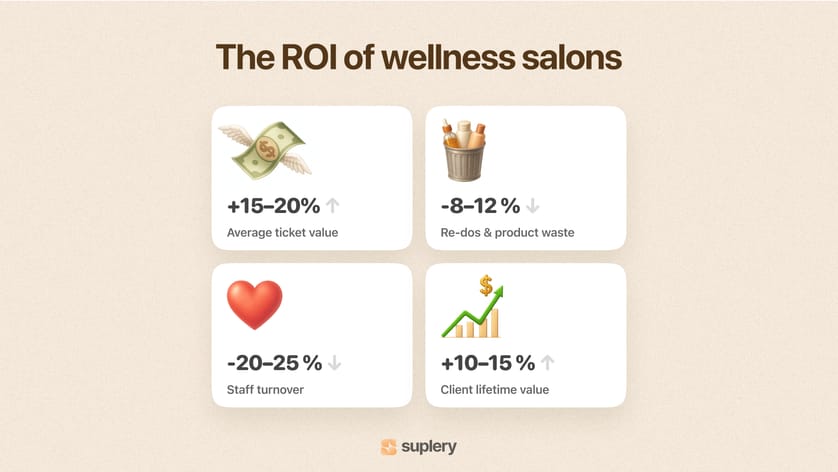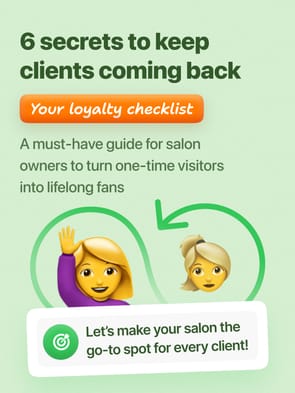Calm is a new luxury: wellness rituals reshape U.S. salons
Something big is happening in beauty — and it’s not another color trend.
The modern salon experience is quietly becoming one of the last safe places to breathe in the fast-paced beauty industry.
Clients don’t come in just for nail care or blonding anymore. They come because they’re exhausted — from screens, speed, and noise — and your chair feels like a reset button. The hum of dryers, the scent of essential oils, the warmth of hands: together, these moments create what clients crave most today — calm, connection, and self care.
We’ll uncover how U.S. salons are turning wellness into their secret advantage — and why the future belongs to those who make clients feel something, not just look good.
What wellness really means in salons 🌿
“Add a diffuser and call it wellness” — that’s not what this movement is about.
Real salon wellness isn’t décor-deep; it’s experience-deep — a new layer of mindfulness and emotional balance that’s redefining the modern beauty industry. Across the country, salon owners are realizing that calm and connection have become the new currency of client trust and loyalty.
Wellness in a professional beauty space means designing every touchpoint — from the lighting to the language — to reduce stress, activate the senses, and remind your guest: you can exhale here.
This is where a simple appointment turns into a ritual. When the environment is curated with attention, warmth, and a personalized approach, guests experience a deeper sense of belonging and peace. That’s what drives exceptional customer experience and creates loyal clients who return not just for results, but for how they feel.
Here’s how leading salons interpret it through seven simple pillars — a framework you can borrow, adapt, and scale at any size or type of services.
7 pillars of salon wellness
Sensory design 🕯️
Wellness starts before the service even begins. Think how a guest feels the moment they walk in.
Soft neutral lighting instead of overhead glare, a calm scent that signals “slow down,” and a curated playlist that follows the day’s rhythm — these subtle sensory cues help restore wellbeing and invite relaxation.
In many spaces, this sensory focus blends seamlessly with spa rituals and holistic treatments — from head spas and scalp care to small details like herbal tea or essential oils. These gestures combine high quality products with emotional precision, turning each hair care moment into a ritual of renewal.
70% of salon clients say the ambience affects how much they’re willing to spend. When the space feels restorative, pricing becomes secondary — because calm is the new luxury.
Touch rituals 💆♀️
Adding intentional moments of contact turns a technical service into a ritual: scalp massages during shampoo, gua sha for lymphatic release, or warm-towel compresses after treatment. These micro moments of presence are what separate a standard appointment from a true act of self care.
Japanese-inspired head spas are leading the charge, mixing aromatherapy, acupressure, and scalp health diagnostics into deeply relaxing experiences. Salons like Penzone (Ohio) have even introduced full “Head & Sound” rituals, blending scalp care with guided meditation and sound bowls.
The result is higher perceived value, repeat bookings, and a new kind of client — one who values both results and feelings. These experiences strengthen customer loyalty and redefine what the modern salon experience means in the era of calm.
Mindful modes ☁️
Not every guest wants conversation — some want quiet.
“Mindful modes” are becoming the next loyalty driver across the beauty salon landscape: scheduled quiet hours, noise-free zones, stylists trained to read energy cues, and optional breathing moments before a service starts. These subtle personal wellness rituals help transform an ordinary visit into an act of self-awareness and balance.
For many salon owners, this shift is part of larger salon industry trends — where businesses no longer just provide services, but design experiences that support mental calm and emotional reset.
New York’s Sundays Studio built its entire identity around mindful manicures, offering 10-minute meditations during polish. Their founder, Amy Lin, reports that clients don’t just return — they bring friends “for peace, not polish.”
It’s the easiest entry point into wellness: no equipment, no cost — just presence, empathy, and intentional service.
Inside-out care 🫖
Hydration bars and functional beverages are quietly becoming the new hospitality baseline in modern salons.
A $1 herbal tea can create a $10-luxury feeling, and a collagen drink can double as retail storytelling. When combined with holistic treatments or self care rituals, they become small but powerful ways to communicate brand values.
Spas like G2O in Boston or Heyday in L.A. are serving adaptogenic blends, electrolytes, or branded “calm tonics” that turn waiting time into wellness time. These details — paired with high quality products and thoughtful presentation — create moments of stillness clients remember.
You don’t need a full bar — start with a ritual drink: something seasonal, caffeine-free, and beautiful enough to photograph. It’s one of those unique benefits that quietly elevates your beauty salon into a sanctuary.
It’s a small act of care that signals: “We think about your wellbeing, not just your hair.”
Turning services into rituals
If wellness sounds abstract, this is where it becomes tangible — and profitable.
Ritualizing your salon services isn’t about candles or incense. It’s about engineering sensory precision — designing moments that quiet the nervous system, spark oxytocin, and make clients associate your brand with balance, comfort, and self care.
Every beauty salon service already has a sequence: greet, prep, perform, finish. When you shift that sequence into a sensory journey — with intention behind each touch, sound, or pause — it becomes a wellness ritual.
Use the natural textures, scents, and natural ingredients in your high quality products to turn routine steps into sensory experiences. Even simple hair care moments or holistic treatments can awaken the senses, soothe the body, and relax the mind when delivered with empathy and intention.
Rituals build memory, create emotional differentiation, and strengthen relationships — they build trust between stylist and client far more effectively than discounts ever could. They turn an ordinary treatment into a meaningful experience that defines the modern salon industry.
For salon owners, this mindset is also a strategic investment — a way to stay relevant and stay ahead in a competitive market. Each sensory detail, from personalized consultations to curated retail products or small product bundles, delivers unique benefits that elevate your positioning and increase long-term loyalty.
Rename and reframe — language as a luxury signal
Words dictate value perception long before the service begins.
Clients read your menu and decide whether what they’re buying is a commodity or a ceremony — a small moment of care or a full sensory escape. Incorporating wellness-inspired wording during personalized consultations helps clients instantly sense your value — and connects physical relaxation with emotional reassurance.
- “Treatment” sounds clinical — something to fix.
- “Ritual” sounds restorative — something to experience.
- “Add-on” implies optional extras.
- “Moment of care” implies importance.
By changing labels, you’re not just editing copy — you’re reframing identity and elevating your salon experience into something emotionally charged, sensory, and deeply human. This kind of mindful storytelling helps you stay ahead of trends and shows that every detail — from technique to tools — is designed with intention.
Example transformations:
| Old wording | New ritual name | Emotional cue |
|---|---|---|
Scalp Detox | Head Spa Renewal | Purification, renewal |
Moisture Mask | Hydration Ritual | Nurture, softness |
Toner Gloss | Shine Alignment | Balance, glow |
Classic Blowout | Energy Reset Styling | Uplift, empowerment |
Quiet Appointment | Silent Color | Grounded calm |
Rule of thumb:
Every word on your service menu should either soothe or seduce. If it doesn’t evoke calm, connection, or confidence, rephrase it — because in today’s beauty industry, language is part of the wellness experience. For salon owners, the right phrasing becomes more than branding — it’s a mindful investment in how people perceive your work and connect with your space.
3-tier wellness menu (and why it works psychologically)
A tiered salon menu helps clients self-select their depth of care — without feeling sold to. It mirrors wellness psychology: people progress naturally from curiosity → comfort → commitment.
This structure gives salon owners the ability to nurture both business and emotional loyalty. When every touchpoint feels intentional, clients sense your care — and that’s where long-term trust begins to grow.
💧 Tier 1 — Express Rituals (no-cost, low-time)
Purpose: prime the senses before the main service.
These are the micro-moments that cost nothing but feel priceless — small rituals that elevate relaxation and mindfulness without adding time. They make the physical experience of beauty care feel restorative for both body and soul.
Examples:
- Warm towel compress before shampoo.
- Client chooses an aroma: lavender (calm), citrus (focus), or mint (refresh).
- 60-second breathing cue: “Take a deep breath in while we apply this mask.”
- Herbal tea or infused water during consultation.
- Eye pillow or sound-free playlist option during toning time.
Business impact: These rituals don’t extend appointment length, but they raise perceived service quality by 15–20%, according to salon experience studies. They build emotional equity — clients begin to see your salon as a sanctuary, not a transaction — a true moment of self care in their day. Each mindful gesture also helps reduce waste and optimize product use, proving that sustainability and serenity can coexist beautifully.
🧴 Tier 2 — Core Rituals (low-cost add-ons)
Purpose: enhance recovery and engagement.
These are quick, sensory extensions that bridge care and profit, turning every treatment into a deeper act of wellness. They combine thoughtful service with premium details that make each visit feel personal and complete.
Offerings ($10–$30 range):
- Scalp Rebalance Massage (5–7 minutes): improves circulation, reduces stress hormones.
- Sound Bath Headphones: a 10-minute meditative audio track synced with color processing time.
- LED Glow Finish: mini LED session during a mask or gloss for collagen boost and calm.
- Detox Mask + Aromatic Steam: gentle scalp detox under warm mist.
Each of these small additions fits naturally into existing service windows (color processing, mask time). They don’t slow down turnover yet add $15–$25 to the ticket — boosting both revenue and client satisfaction. At volume, that’s a $1,500+ monthly lift for an average four-chair salon.
Implementation tip: Train stylists to offer, not sell. When team members know how to recommend with empathy and confidence, retail becomes part of the care experience — not a pitch.
👉 Learn the psychology and scripts behind it in our full guide: How to sell beauty products to clientsand not sound salesy.
🪄 Tier 3 — Signature Rituals (premium, branded experiences)
Purpose: anchor your brand identity and loyalty.
These are the rituals that make your salon memorable — a blend of art, science, and emotion. They’re photogenic, emotionally charged, and justify premium pricing while reinforcing the wellness-focused experience clients now expect.
Each ritual is an opportunity to showcase craftsmanship — from natural ingredients and soothing aromas to sensory details that engage every sense. These experiences remind clients that beauty isn’t only what they see — it’s what they feel.
Examples:
- Glow Inside Out Ritual — hair treatment + guided meditation + collagen tonic + post-care playlist emailed after service.
- The Reset Session — scalp exfoliation + infrared head wrap + aromatherapy massage + silent styling.
- Energy Renewal Journey — 90-minute full transformation with tea ceremony, affirmations, and scalp LED therapy.
Average ticket: $120–$250 Average time: 75–120 min Average margin: 45–60%, because perceived value far outweighs material cost.
Signature rituals also create organic marketing. Clients share them as experiences, not services — proof of emotional connection that no paid ad can replicate. Each visit reinforces loyalty and keeps your brand relevant in a world where calm has become the ultimate luxury.
The upsell ladder: from sensory entry to emotional loyalty
The genius of this structure lies in how people grow with your menu.
- First-time visitors try Express rituals → form positive emotional memory.
- Returning clients naturally move into Core rituals → mild paid upgrades.
- Loyal guests book Signature rituals for birthdays or self-care days → highest spend, most referrals.
No pressure, no hard sell — just psychological pacing that feels organic. Every tier acts as a step in a long-term relationship instead of a one-time transaction, proving that consistency and empathy are the ultimate growth strategy for any modern beauty salon.
Operational layer: making rituals repeatable
To turn a beautiful idea into a business process and maintain a consistent wellness experience across all services:
- Standardize scripts and timing. Write 1-minute intros for each ritual; train stylists to keep flow consistent and service quality high.
- Create cue cards at stations — aroma options, breathing prompts, massage steps — using sensory tools that inspire confidence and flow.
- Measure what moves revenue. Track add-on uptake %, client feedback, and rebook rate to refine salon services and identify what truly enhances wellbeing.
- Assign wellness champions. Each team member “owns” one ritual category (sound, tea, scent, touch) to sustain team engagement and physical balance.
- Refresh quarterly. Rotate scents, teas, and playlists to keep experiences seasonally fresh, soulful, and aligned with the rhythm of client self care.
By turning intentional care into a system, salon owners don’t just maintain harmony — they invest in it. These thoughtful habits create loyal clients, strengthen brand equity, and ensure your wellness rituals remain timeless.
Designing emotional choreography
Think of your appointment as a small piece of theater — not performative, but paced with care and intention.
- Opening – sensory welcome (aroma, light, warmth).
- Rising action – moment of silence or mindfulness during application.
- Climax – the transformation (rinse, reveal, massage).
- Resolution – closing ritual (tea, reflection, affirmation).
That rhythm calms the nervous system — and signals intentionality. It’s how a haircut becomes therapy, and a facial becomes restoration. In this flow, every sensory detail — from natural ingredients to sound — helps clients reconnect with their body and soul.
The business of calm — ROI, loyalty, and differentiation
Calm is currency.
Every quiet breath, slow movement, and warm towel adds invisible profit — the kind that shows up as loyalty, retention, and repeat bookings. A salon that feels restorative doesn’t compete on price; it thrives on trust, emotion, and meaningful experiences. Guests stay longer, spend more, and recommend it because the calm lingers long after their visit.
Higher revenue per hour 💵
A balanced, mindful environment allows a salon to deliver the same number of appointments with 15–20% higher ticket value — not through upselling, but through a more elevated, sensory experience.
Clients in a relaxed state accept premium pricing more easily, purchase with less hesitation, and rebook faster.
This effect compounds across the schedule: even a $7–10 increase per visit can lift annual revenue by tens of thousands without extending service time — proving that calm truly drives financial growth in the beauty industry. Thoughtful attention to detail and emotional value naturally strengthen both loyalty and profitability.
Lower operational losses 🧩
Stress creates hidden costs — product waste, re-dos, errors, and early staff turnover.
Introducing structured wellness habits — breathing routines, mindful breaks, and softer pacing — can reduce re-dos by 8–12% and staff attrition by up to 25%, cutting training and hiring expenses dramatically.
Sustainable practices and smarter tools also help reduce waste while maintaining a calm atmosphere for both team and guests. Every stylist retained for an extra year represents $5,000–10,000 in preserved margin through consistent bookings and fewer onboarding gaps — a simple shift toward wellbeing that protects both balance and performance.
By investing in systems that honor rhythm and rest, teams stay focused, clients feel cared for, and the business continues to grow naturally in a wellness-driven market.
Stronger client lifetime value ⏳
Clients who associate a salon with calm and self care stay longer in the ecosystem — they become loyal guests whose trust turns into measurable growth.
They rebook, make referrals, and purchase thoughtfully selected products — the trifecta of organic expansion. Each repeat visit strengthens emotional connection, while small rituals reinforce their sense of belonging.
If a regular guest adds just one extra visit per year because the salon feels restorative, lifetime revenue per client grows by 10–15% while acquisition cost stays fixed. Emotional retention becomes a financial buffer, turning every act of care into measurable value.
Brand differentiation that compounds 📈
When competitors fight on speed and discounts, calm becomes the new definition of luxury.
A wellness-oriented salon doesn’t chase noise — it builds consistency and trust. Such brands earn authority pricing and secure top-tier reviews that double as organic marketing. Clients instantly recognize authenticity — real care, mindful service, and balance speak louder than promotions.
That perception stabilizes cash flow and shields margins from slowdowns — because emotional connection and loyalty hold value even when budgets tighten. This approach isn’t just branding; it’s an investment in long-term reputation and sustainable growth.
Calm as the next growth model
The next era of beauty isn’t defined by louder brands or faster workflows — it’s defined by precision calm.
The salons that win will be those that design revenue around recovery, not rush. By blending mindfulness, high quality tools, and unique benefits that nurture both body and soul, they create something timeless: care that feels human.
When a business protects peace, every stakeholder benefits: the owner earns stability, the team gains longevity, and the client feels cared for in a way automation can’t replicate.
✴️ Simplify that structure with Suplery — the platform that keeps your operations steady, inventory smart, and atmosphere undisturbed. Because profit grows best where the team can breathe.
Spin up Suplery today
Get real-time shelf tracking, automated reorders, and multi-location control — so you cut waste, save hours, and keep every chair revenue-ready.
Try Suplery now The latest articles and industry insights delivered to your inbox
The latest articles and industry insights delivered to your inbox
Subscribe to receive a monthly digest of our most valuable resources like blog posts, whitepapers, and guides.
Oh no! We couldn’t subscribe you ☹️
Done! You've subscribed 💛
Unsubscribe anytime. Your data is stored for business-to-business communication purposes. See our Privacy policy.
Frequently asked questions
How can a salon maintain efficiency while adding rituals?
Integrate wellness gestures into idle time — a scalp massage during color processing, LED light during a mask, or a tea service during check-in. The key is layering, not extending. Create a routine that blends personal wellness rituals with existing services: a rejuvenating facial while a gloss sets, or sound therapy while color develops. Provide services that feel restorative for both body and soul. Use online tools to book appointments online efficiently and personalize experiences without increasing time per client. This mindful structure helps reduce waste, boost productivity, and sustain profitability while adding emotional value.
Do clients genuinely pay more for wellness-infused experiences?
Yes. The U.S. wellness economy exceeds $1.8 trillion, and salon clients now associate calm, care, and high quality products with true luxury. Wellness services in the beauty industry increase satisfaction, strengthen customer loyalty, and drive 10–30% higher spending. They also open opportunities for retail products, product bundles, and self care add-ons that enhance perceived value. Salon owners who invest in these experiences quickly see that mindfulness and empathy are not just soft skills — they are powerful business tools that build trust and longevity.
How to communicate wellness professionally?
Use clear, sensory language: comfort, focus, recovery, hydration, rest. Clients respond best to tangible, descriptive calm — not abstract spirituality. Frame treatments as rituals that enhance wellbeing, balance, and energy restoration. Highlight unique benefits like holistic treatments, spa rituals, or personalized consultations. Showcase your high quality products and natural ingredients to communicate authenticity. This language and tone position your beauty salon as a self care destination and help loyal clients feel seen, understood, and cared for.
How to motivate the team to support wellness initiatives?
Start internally. Offer staff five-minute grounding breaks, ergonomic upgrades, or optional meditation playlists. Encourage stylists to share feedback, co-create rituals, and practice mindfulness as part of their daily routine. When stylists feel balanced physically and emotionally, they provide higher quality service and a more peaceful environment. This investment builds trust, strengthens the team’s soul connection to their work, and results in an exceptional customer experience that clients can sense immediately.
Which low-cost rituals deliver the highest return?
- Herbal or collagen drink upon arrival.
- Two-minute scalp touch ritual.
- “Quiet hour” scheduling option.
- Warm towel before rinse.
Each small moment enhances relaxation, connects the senses, and turns a visit into a personal act of care. These simple touches — paired with thoughtful use of holistic tools and sustainable practices — help reduce waste, support emotional balance, and create loyal clients who come back for both results and feeling.
How to evaluate the financial impact?
Track three key metrics:
- Rebook rate: target +15–20%.
- Average ticket: aim for +8–12%.
- Staff turnover: expect a decline within 3–6 months.
Combine data with client reviews mentioning relaxed, balanced, comfortable, or restorative. These words reflect emotional loyalty — the true measure of success for wellness-driven salons. Also, track sales of retail products and product bundles — they indicate growing trust and engagement. For salon owners, this approach not only strengthens financial performance but also ensures long-term sustainability, helping the brand stay ahead in a changing world.
Last updated on Oct 15, 2025
A new flagship article that reframes calm, care, and mindfulness as the modern salon’s strongest advantage.
1. Harvard Business Review — The Experience Economy Revisited (2022)
2. PubMed — Scalp Massage Effects on Stress Hormones (2016)
3. Journal of Alternative & Complementary Medicine — Lavender Aromatherapy and Sleep (2019)
4. American Spa — 2025 Spa & Wellness Trend: Holistic Healing (2024)
5. American Spa — 2025 Spa and Wellness Trend: An Increase in One-Stop Wellness Destinations (2024)
Please share this post
Table of Contents
7 pillars of salon wellnessTurning services into rituals3-tier wellness menu (and why it works psychologically)The upsell ladder: from sensory entry to emotional loyaltyThe business of calm — ROI, loyalty, and differentiationCalm as the next growth modelFrequently asked questionsStress-free salon sales: train your team to recommend with confidence
Struggling to get your salon team comfortable with selling? Learn practical ways to help staff recommend products naturally, improve client experiences, and boost sales—without feeling pushy or awkward. Simple, useful tips for any salon owner.
Beauty salon operations & Team management
11 min
Reducing salon costs: effective strategies for expense management
Struggling to manage salon expenses? This article breaks down simple ways to cut costs without sacrificing quality. Find tips you can actually use to keep your salon running smoothly and profitably.
Beauty salon operations & Team management
13 min
How to motivate team for sales: implementing staff incentives
Are you stuck in a rut with your salon sales? Your team could be the key to unlocking greater success! This guide delves into how staff incentive programs might inspire stylists and increase your bottom line.
Beauty salon operations & Team management
5 min
Unlock FREE bonus material!
Get your hands on "Your loyalty checklist: 6 secrets to keep clients coming back". Subscribe to our newsletter and receive a link to download it straight to your inbox.
Oh no! We couldn’t subscribe you ☹️
Done! We've sent a link to your Email 📨
Trusted by the best in the beauty industry.
Transform your beauty business with Suplery!
Already enjoying our expert tips? Take the next step and join Suplery to revolutionize your business operations.
Huge range of professional products
One-click checkout after first order
Automated predictive orders
Seamless inventory management
From words to action
Start working with Suplery and explore all the tools and services you need to expand your business
Get started with Suplery24/7 Support
Secure payments
Designed by industry’s experts
